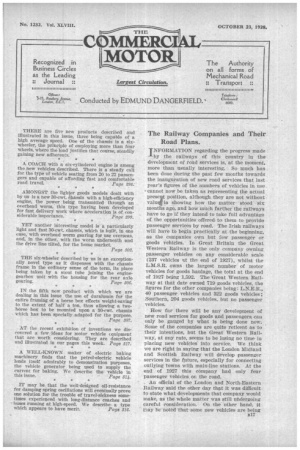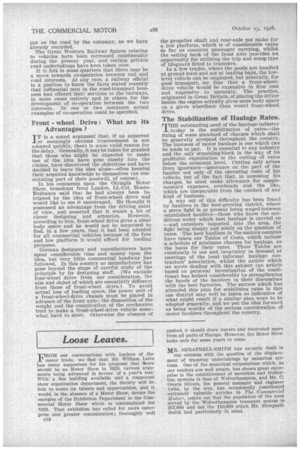The Railway Companies and Their Road Plans.
Page 1

Page 2

If you've noticed an error in this article please click here to report it so we can fix it.
TNFORMATION regarding the progress made —I— by the railways of this country in the development of road services is, at the moment, more than usually interesting. So much has been done during the past few months towards the inauguration of new road services that last year's figures of the numbers of vehicles in use • cannot now be taken as representing the actual preset position, although they are not without valu in showing how the matter stood six months ago, and how much farther the railways have to go is they intend to take full advantage of the oppertunities offeredto them to provide passenger services by road. The Irish railways will have to begin practically at the beginning, as the companies own but few passenger or goods vehicles. In' Great Britain the Great Western Railway is the only company owning passenger vehicles on any considerable scale (237 vehicles gt the end of 1927), whilst the L.M.S.R. owns the largest number of motor vehicles for goods haulage, the total at the end of 1927 being 1,592. The Great Western Railway at that date owned 719 goods vehicles, the figures for the other companies being: L.N.E.R., 40 passenger vehicles and 322 goods vehicles ; Southern, 204 goods vehicles, but no passenger vehicles.
How far there will be any development of new road services for goods and passengers can only be gauged by what is being done now. Some of the companies are quite reticent as to their intentions, but the Great Western Railway, at any rate, seems to be losing no time in placing new vehicles into service. We think we are right in saying that the London Midland and Scottish Railway will develop passenger services in the future, especially for connecting outlying towns with main-line stations. At the end of 1927 this company had only four passenger vehicles on the road.
An official of the London and North-Eastern Railway said the other day that it was difficult to state what developments that company would make, as the whole matter was still undergoing careful consicleratim. On the other hand, it may be noted that some new vehicles are being
put on the road by the company, as we have already recorded.
The Great Western Railway figures relating to vehicles have been increased considerably during the present year, and certain private road undertakings have been taken over.
It is felt in some quarters that there may be a move towards co-operation between rail and road interests. At any rate, a railway official in a position to know the facts stated recently that infinential men in the road-transport business had offered their services to the railways, in some cases entirely and in others for the development of co-operation between the two interests. In one or two instances actual examples of co-operation could be specified.
Front wheel Drive : What are its Advantages ?
IT is a sound argument that, if an apparent or seemingly obvious improvement is not adopted quickly, there is some valid reason for the delay. Generally, it may be taken for granted that those who might be expected to make use of -the idea have gone closely into the claims, have discovered the objections and have decided to leave the idea alone—often keeping their acquired knowledge to themselves (as constituting part of their goodwill, of course).
In his comments upon the Olympia Motor Show, broadcast from London, Lt.-Col. MooreBrabazon said that he had always been intrigued by the idea of front-wheel drive and would like to see it encouraged. He thought it possessed an advantage from the driving point of view, and asserted that it wants a lot of clever designing and attention. However, according to him, front-wheel drive gives a clear body space and he would not be surprised to find, in a few years, that it had been adopted for all commercial vehicles because of the free and low platform it would afford for loading purposes.
German designers and manufacturers have spent considerable time and money upon the idea, but very little commercial headway has followed. In this country no manufacturer has gone beyond the stage of careful study of the principle by its designing staff. (We exclude four-wheel drive from our consideration, the aim and object of which are essentially different from those of front-wheel drive.) To avoid actual loss of loading space, the power unit of a front-wheel-drive chassis must be placed in advance of the front axle; the disposition of the weight and the cOmplication of the mechanism tend to make a front-wheel-drive vehicle somewhat hard to steer. Otherwise the absence of the propeller shaft and rear-axle 'pot make for a low platform, which is of considerable value so far as concerns passenger carrying, whilst the setting back of the front axle provides an opportunity for utilizing the trip and scoop type of lifeguard fitted to tramcars.
In a few trades, where the goods are handled at ground level and not at loading bays, the lowlevel vehicle can be employed, but generally, for good transport, we fear that a front-wheeldrive vehicle would be expensive in first cost and expensive to maintain. The practice, originated in Great Britain, of placing the driver beside the engine actually gives more body space on a given wheelbase than would front-wheel drive.
The Stabilization of Haulage Rates. mHE outstanding need of the haulage industry
to-day is the stabilization of rates—the fixing of some standard of charges which shall be generally accepted throughout the country. The business of motor haulage is one which can be made to pay. It is essential to any industry and the only stumbling-block in the way of its profitable exploitation is the cutting of rates below the economic level. Cutting only arises from ignorance—ignorance on the part of the haulier not only of the operating costs of his vehicle, but of the fact that, in assessing his charges, he must make allowance for supplementary expenses, overheads and the like, which are inseparable from the conduct of any kind of business.
A way out of this difficulty has been found by hauliers in the beet-growing district, where a stern fight is at present being waged between established hauliers—those who know the conditions under which beet haulage is carried on —and outsiders imported into the area, the fight being simply and solely on the question of rates. The beet hauliers in the eastern counties have taken our Tables of Costs, which include a schedule of minimum charges for haulage, as the basis for their rates. These Tables are constantly in use and invariably in demand at meetings of the local informal haulage contractors' association, whilst the article which we wrote dealing with this subject (an article based on personal investigation of the conditions) has helped considerably by strengthening the hands of the hauliers in their discussions with the beet factories. The suCcess which has attended this plan for stabilizing rates in this one district may well be taken as indicative of what might result if a similar plan were to be adopted generally, and we put the idea forward as being worthy of the serious consideration of motor hauliers throughout the country.


































